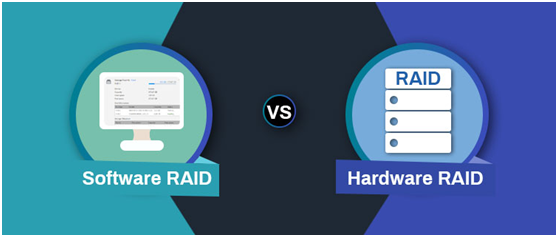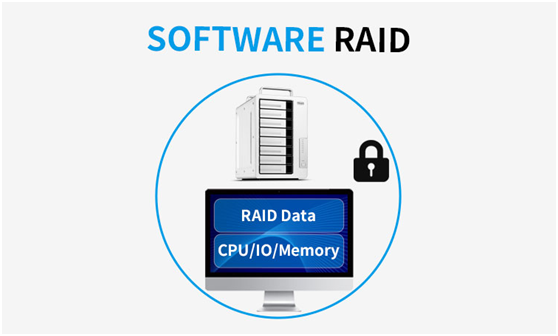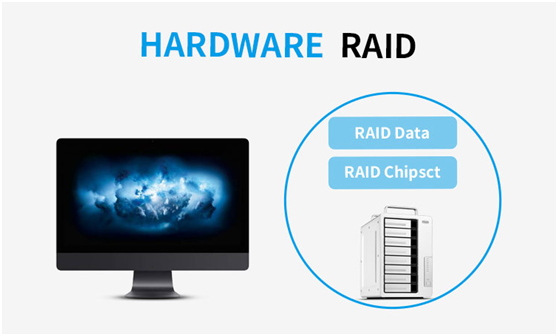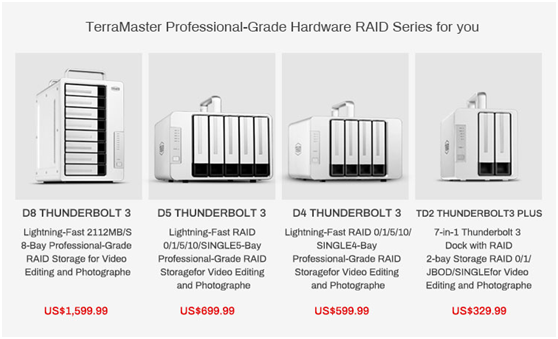Software RAID VS. Hardware RAID:Pros and Cons for each

In the last couple of years, RAID technology has grown from a server option to a data protection requirement.
RAID is now found everywhere–from operating system software features to stand-alone controllers providing advanced data integrity in high-end storage area networks.
What is RAID?
RAID is an acronym for Redundant Array of Independent Disks.
RAID is a data storage virtualization technology that combines multiple physical disk drive components into one or more logical units for the purposes of data redundancy, performance improvement, or both.
Data is distributed across the drives in one of several ways, referred to as RAID levels, depending on the required level of redundancy and performance. The different schemes, or data distribution layouts,
are named by the word "RAID" followed by a number, for example RAID 0 or RAID 1. Each scheme, or RAID level, provides a different balance among the key goals: reliability, availability, performance, and capacity.
RAID levels greater than RAID 0 provide protection against unrecoverable sector read errors, as well as against failures of whole physical drives.
The different modes (mirroring, striping and parity) are used to define the different RAID levels. Processing is required to carry out those actions, and that can take place on the host server's OS or in the storage array
or controller which also called software RAID or hardware RAID. So, what are the pros and cons of software RAID vs.hardware RAID?
What is software RAID?
A simple way to describe software RAID is that the RAID task runs on the CPU of the computer system. It is a built-in function on many operating systems that can convert the disks connected to the server into a RAID
array. All you need to do is to connect the drives and configure the desired RAID level.
It is important to understand that the software RAID code utilizes the computing power of the CPU and shares computing power with the operating system and all related applications.
This will inevitably increase the overall burden on the server and may reduce the speed of RAID calculations. Once the operating system loads the RAID driver software, the RAID will become active.
Many server operating systems support RAID configurations, including Apple, Microsoft, and various versions of Unix/Linux systems. Generally, software RAID depends on the
operating system of the computer, therefore it cannot be used for partitions shared by multiple operating systems.
What are the PROS and CONS of software RAID?
|
PROS |
CONS |
|
Low cost |
Increasing the burden of the computer operating system
|
|
Easy to install |
Replace a failed disk is relatively complicated
|
|
Same RAID driver can be implemented to the same operating system. |
Limited to the RAID levels supported by a specific operating system.
|
|
If the processor performance is strong, it can easily handle RAID 0 and RAID 1 |
Performance will significantly decrease with complex RAID configuration
|
|
|
Can’t be used for disks shared by different operating systems.
|
|
|
Easily attacked by viruses, not protected at startup, system crashes will cause data loss.
|
What is hardware RAID?
For hardware RAID, all drives are connected to a hardware RAID controller, which can be located on a separate RAID card, on a different server or built into the motherboard. The hardware RAID controller manages
the RAID array, configures and supports multiple RAID levels. It contains a microprocessor (often called an I/O processor, or ROC ‘RAID on Chip’). In some cases, RAID controllers with their own processors can act as
mini-computers because they have the ability to perform tasks independently.
During the hardware RAID installation process, the drive is connected to the RAID controller board. This applies not only to large servers, but also to desktop computers. Processing hardware RAID refers to discrete
controllers at the disk storage system level (such as ATA RAID, SATA, DELTA PLC, etc.). 
What are the PROS and CONS hardware RAID?
|
PROS |
CONS |
|
Will not occupy or affect the performance of the computer or server.
|
The cost is higher than software RAID
|
|
Compatible with different operating systems. |
If your RAID controller fails, you must find a compatible RAID controller to be replaced
|
|
|
|
|
It is easy to replace a failed disk
|
|
Why is hardware RAID better than software RAID?
If uptime and stability are important to you or your business, hardware RAID is very useful. Backup will help you to avoid catastrophic data loss. However, restoring large amounts of data (for example,
in the event of a drive failure) may take several hours to perform. Hardware RAID allows you to withstand the failure of one or more drives without losing data and in many cases without causing any downtime.
Hardware RAID is also useful if you are experiencing speed issues in multitasks, when applications are waiting to perform tasks on disk. By using hardware RAID, you can ensure that the high-speed array reads and
writes data at a high speed, thereby providing you with additional throughput. In addition, if you use hardware RAID, the hardware RAID controller will include additional memory as a cache, which reduces the
burden on the physical hardware and improves overall performance.
Do I need a hardware RAID controller?
Whether you need hardware RAID depends on your usage needs and data importance. If you want to save money (who doesn't?), then you can use a single operating system to access the RAID array, or you are using
RAID 0 or RAID 1, then using software RAID can have the same RAID protection and experience instead of higher-cost similar products.
The hardware RAID solution has more features, higher performance and data security, which is especially suitable for video editing professionals. If you can handle the initial investment, then hardware RAID is
definitely the way to go. It can make you get rid of the limitation of software RAID, and give you greater flexibility in usage and configuration types.
How to choose Hardware RAID controller?



